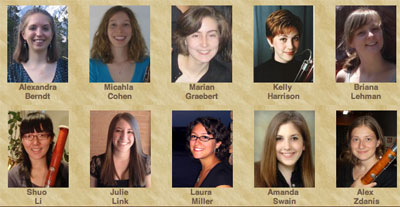by Daniel Hathaway
Semi-final rounds of the Meg Quigley Vivaldi Competition got underway early Friday afternoon as nine bassoonists took the stage in the Oberlin Conservatory’s Kulas Recital Hall. The nine (originally ten, but one withdrew due to injury) were chosen from a pool of 47 applicants through video submissions.
In order this afternoon, we heard Kelly Harrison (Oberlin); Laura Miller (graduate student, University of Texas at Austin); Shuo Li (Oberlin, from China); Marian Graebert (graduate student at the University of Akron), Amanda Swain (graduate student at Northwestern); Alex Zdanis (Colburn School); Briana Lehman (Rice); Julie Link (graduate student at CIM); and Micahla Cohen (graduate student at Yale).
Each contestant played three required pieces, cleverly chosen to demonstrate each individual’s technique and musicianship, interpretive skills and to measure how they projected their musical personality to an audience. Three judges would independently rank each player and cumulative scores would determine which five performers would advance to the finals on Sunday at 3pm in Warner Concert Hall.
Vivaldi’s 26th concerto, rarely played due to its technical-musical difficulties, will appear again in the finals in a version specially edited for the MQVC by Nicholas McGegan, Nadina Mackey-Jackson and Guy Few. Today, the first two movements were required, and were to be played from memory.
The second required piece, Brazilian composer Francisco Mignone’s Valsa da outra esquina (from 16 Waltzes), puts the player directly in the glare of the spotlight (no accompaniment, and lots of interpretive intervention required).
Finally, Libby Larsen’s Concert Piece for Bassoon and Piano (first movement) puts the bassoonist and her instrument through a whole range of challenging effects and extended techniques (not to mention her collaborative pianist–some brought their own pianists, but Conservatory professor James Howsmon was the valiant partner for at least six of the bassoonists).
In addition to putting the contestants through a trial by music, MQVC also requires them to do a bit of public speaking (isn’t that Americans’ greatest fear?) Each was compelled to speak to the audience about themselves and the repertoire before beginning to play.
Going through all of this amounts to fifteen minutes of soloistic fame (or perhaps torture) for instrumentalists who are usually buried deep within the orchestra, doing their day-to-day thing of supporting the wind section from the bottom up. But then, part of the mission of MQVC is to empower young women, and it seems to be working very nicely.
The first impressions we had of the players, then, was verbal rather than musical. Some were informal, off the cuff and engaging, some seemed to be reciting carefully written, memorized paragraphs. Our personal favorites were Julie Link, who spun a little yarn about a conversation on a plane and shared some insightful little details about her life, and Briana Lehman, who shared some “fun trivia” about the music.
The Vivaldi movements that followed each speech gave an almost instantaneous impression of each player’s tone quality, projection and technique, depending on whether individual contestants decided to somehow play along with the orchestral introduction. An amazing range of timbre was on display this afternoon from buzzy and hollow through rich and woody, to just plain opulent, consistent from top to bottom or different from register to register. Leaping arpeggios and internal details were often nimbly handled, or sometimes a little messy and blurred. Some tempos were brisk and straightforward, others got rushed or were bent to accommodate difficult passages. Phrasing was sometimes long and well-constructed, sometimes a bit irrational (a phrase continued until you had to breathe). One heart-stopping memory slip compromised an otherwise fine performance.
The Mignone was a litmus test of interpretation. Only a few contestants really got the idea that this was a waltz (and had some kind of ternary rhythm lurking beneath its abundance of notes), and only a few of those managed to make it sound folksy and Brazilian rather than well-behaved and European. One particular feature of the piece that needed interpretive intervention from the performer is a series of repeated low notes answered by higher pitches. Some played this verbaitim, others put some spin on the passage through articulation and dynamics.
In writing about her Concert Piece, Libby Larsen notes: “There is a storytelling quality built deeply into the composition of this piece. It is important to grasp and relay this quality through the music itself”. Told to “rock” and “scream” at one point or another, the player not only has to negotiate some very tricky passages, but to mold the performance in a way that makes sense to the ears on the other side of the footlights.
Some contestants just played the score literally. Others seized the opportunity to put their own personal stamp on the performance (in one particular instance, where a long note is simply marked “bend”, a variety of interpretations were possible, and responses ranged from just a wide vibrato to really woozy effects). In the last piece on the program, some contestants (Alex Zdanis and Julie Link in particular ) finally relaxed and began looking like soloists, adding some body language and expressive physicality to the music.
This afternoon’s session demonstrated an impressive wealth of bassoon talent. The three judges would submit their scores and finalists would be announced tonight at 6 pm.




